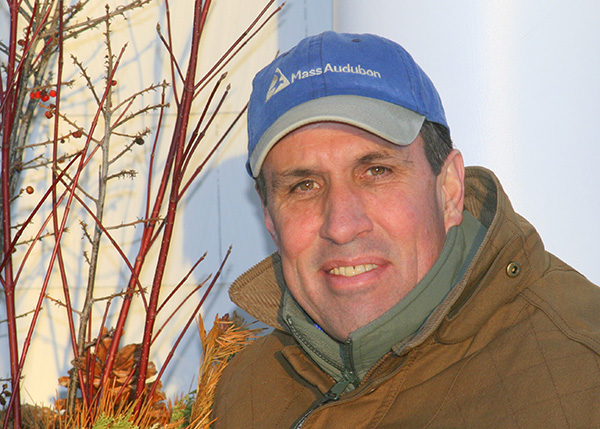A HISTORY OF WINTER CROW ROOSTS AND A VISIT TO A ROOST IN LAWRENCE, MASSACHUSETTS
By Dana Duxbury-Fox
 American Crows. Illustration by Barry Van Dusen.
American Crows. Illustration by Barry Van Dusen.
“If men had wings and bore black feathers, few of them would be clever enough to be crows.” Reverend Henry Ward Beecher
American Crows (Corvus brachyrhynchos) and Fish Crows (C. ossifragus) traditionally roost communally in winter. Across their range, many of these roosts have been in existence for a number of years. Very large roosts tend to occur in regions where there is abundant food, and also where northern migrants augment resident crow populations, as in Oklahoma (Good 1952).
Communal roosting by large numbers of crows is not well understood. Sibley (2001) offers some explanations:
Some evidence indicates that information about profitable foraging areas may be passed on at roosts; hungry birds follow well-fed ones to better feeding sites the next day. Another explanation is that the birds gather near reliable feeding areas, where they can be sure to get something to eat first thing in the morning and again at the end of the day. Large roosts may also offer protection from predators and the comfort of converging at warm, sheltered spots.
In Massachusetts, maximum numbers of crows are recorded in October and March, and many crows are seen during hawk migrations. High counts include 1,000+ in Berkshire County on October 22, 1950; 1500 in Needham on October 30, 1979; and 1175 in Ashburnham on October 27, 1979. In spring, high counts include 700+ in Dartmouth on March 23, 1958, and 600 flying north at Plum Island, on March 15, 1993 (Veit and Petersen 1993).
EARLY HISTORY OF WINTER ROOSTS
The most famous early account of a crow roost was by Alexander Wilson in his American Ornithology (1811). He described a roost that occurred in the late 1700s that:
is near New Castle, on an island in the Delaware. It is known by the name of Pea Patch, and is a low, flat, alluvial spot of a few acres, elevated but little above high-water mark and covered with a think growth of reeds…It is entirely destitute of trees, the crows alighting and nestling among the reeds…
The colony was once destroyed by a tide that flooded the island during “a sudden and violent northeast storm.” Wilson continued: “This disaster, however seems long to have been repaired, for they now congregate on the Pea Patch in as immense multitudes as ever.”
Some reports of roosting crows over the past 200 years sound uncannily like the descriptions of contemporary crow roosts.
Dr. John Godman in his Rambles of a Naturalist, wrote of his observations in 1825 of a roost at his home in Anne Arundel County, Maryland:
The Roost is most commonly the densest pine thicket that can be found, generally at no great distance from some river, bay or other sheet of water which is the last to freeze, or rarely is altogether frozen. To such a roost the crows which are, during the day time, scattered over perhaps more than a hundred miles of circumference, wing their way every afternoon and arrive shortly after sunset. Endless columns pour in from various quarters, and as they arrive pitch upon their accustomed perches, crowding closely together for the benefit of the warmth and shelter afforded by the thick foliage of the pine. The trees are literally bent by their weight, and the ground is covered for many feet in depth by their dung, which by its gradual fermentation must also tend to increase the warmth of the roost. Such roosts are known to be thus occupied for years, beyond the memory of individuals (Godman 1833).
In the winter of 1916–1917, Charles Townsend MD explored a vast American Crow roost at Castle Hill in Ipswich, Massachusetts, and later wrote detailed descriptions of the roost. At that time, 20 or 30 acres of land at Castle Hill were covered with mature evergreens, mostly European scotch and Austrian pines, and patches of deciduous trees.
He noted that by 3:00 pm, three streams of crows began their flight to the roost, gathering first in the dunes or in the fields below the hill. An hour later, he and his companions saw a flock stretching for two miles that took four minutes to pass their observation point. Sunset was at 4:15 that day and it was dark when many of the birds finally went into the evergreens to roost. He calculated that there were 12,000 birds in the roost (Townsend 1918).
 Crow pellet found at the Lawrence Winter Roost. All photographs by Craig Gibson.
Crow pellet found at the Lawrence Winter Roost. All photographs by Craig Gibson.
Townsend was fascinated by the pellets of indigestible material that the crows disgorged. He collected many pellets from the Castle Hill roost and had them analyzed by the U.S. Biological Survey. Analysis determined that the pellets contained mainly bayberry seeds, along with seeds of poison ivy, staghorn sumac, cranberry, and barberry. (Townsend 1918). A similar pellet analysis from the Lawrence roost is currently being conducted by Dr. Tom French at the Massachusetts Division of Fisheries and Wildlife.
THE LAWRENCE WINTER CROW ROOST
In the winter of 1989, Eliot W. Taylor first reported American Crows roosting in downtown Lawrence, Massachusetts, a seemingly unlikely location. Lawrence is a city of only six square miles in area, and the Merrimack River, which bisects the downtown area, is lined with many former brick textile mills. The year this roost was established is unknown, but Taylor first noticed the roost on February 2, 1989, when he was driving along Interstate 495, which runs through Lawrence. He saw many crows flying across the road headed into the city and thought, “There must be a roost.” He promptly turned off the highway and followed the crows to a cemetery where he estimated 2000 crows (Taylor, personal communication). On other visits to the roost, he reported 4000 crows (Forster et al. 1990), 8000 crows (Forster et al. 1993), and 11,500 crows (Kellogg et al. 2007).
 Just after sunset on December 28, 2017, hundreds, if not thousands, of crows pour into a staging area on the west side of the O’Leary Bridge Rt. 28/Broadway by the Great Stone Dam.
Just after sunset on December 28, 2017, hundreds, if not thousands, of crows pour into a staging area on the west side of the O’Leary Bridge Rt. 28/Broadway by the Great Stone Dam.
Joseph Hogan of Lawrence also reported winter roost numbers to Bird Observer: 5272 crows (Forster and Rines 1992) and 4256 crows (Forster et al. 1994). Rick Heil reported 10,000–15,000 crows in 2009 (Kellogg et al. 2009).
The Lawrence roost also contains flocks of Fish Crows, which are easily identified by their nasal calls. Before heading to the roost, Fish Crows tend to settle into staging areas in various parking lots separate from American Crows. Skip Charette reported the first Fish Crow at the Lawrence roost on January 13, 1994 (Forster et al. 1994).
There have been no recent documented estimates of the total number of American and Fish crows coming into the Lawrence roost. I observed 5000 American Crows on November 16, 2017.
STAGING
Prior to entering a winter roost, crows usually fly in small flocks from their daytime feeding areas to one or more staging areas during the afternoon. Most arrive at staging areas that are one or more kilometers from the roost an hour before sunset (Moore and Switzer 1998). On cloudy or windy days, they often start flying earlier. Crows do not appear to do much, if any, feeding in the staging areas.
 The National Grid substation on South Canal Street is one of the crows’ staging areas. Crows cover the ground, fill the trees, and perch on the utility wires.
The National Grid substation on South Canal Street is one of the crows’ staging areas. Crows cover the ground, fill the trees, and perch on the utility wires.
Interestingly, crows that are members of cooperative breeding groups—usually many of the permanent resident crows—leave the feeding area independently, do not roost together, and independently leave the roost in the morning (Caccamise et al.1975).
Staging may have evolved to deter persecution and to help keep the roost location secret. Once at the staging area, the crows are social and noisy, with flocks periodically rising and moving to a new spot. At the staging area, the crows may feed, preen, and scan the surroundings (Moore and Switzer 1998). We also have observed some crows going into an almost stupor-like behavior prior to going to roost, as well as at the actual roost. This behavior was particularly noticeable on cold winter days. The birds seemed oblivious to nearby people and hardly moved for long periods of time even when settled on the ground. Unfortunately we are unable explain this interesting behavior.
Staging areas are usually different almost every night. In Lawrence, crows start to pour into the city along the Merrimack River from all directions about an hour before sunset on a winter day. It is a breathtaking experience watching the crows stream in against the background of old textile mills, factories, telephone wires, and lights. They appear immune to the fact that they are settling into a bustling city. No one knows for sure how far away the crows come from. Each night, they seem to choose a different staging area either to the east or the west of their final roosting spot. Every night is like a “Where’s Waldo” puzzle. If it is very cold and the river is frozen, many crows will gather to the west of the roost on the ice above the Great Stone Dam. Or they might go to Pemberton Park on the northwest side of the roost. Other nights they may stream to the east of the roost and gather on either the south or north side of the river—in trees, in parking lots, on buildings, and on the ground. One cloudy night, we found them on the hill to the east of the Lawrence General Hospital. The noise is always considerable. There is constant movement of swirling flocks around the staging area.
 Silence falls when the crows settle into their overnight roost.
Silence falls when the crows settle into their overnight roost.
THE ROOST
Once it is dark, usually half an hour after sunset, the crows enter the roost. In some places, crows may use the same roosting site for many years (Emlen 1938, 1940; Black 1941). The total number of birds in a roost varies from a few hundred to more than 500,000 (Gorenzel and Salmon 1992) to 2,000,000 (Iams 1972). Sometimes, crows settle in such high density that the limbs of the roost trees break.
Crows often roost in coniferous trees. In Lawrence, there are no stands of conifers along the Merrimack River, so the crows use the riverine deciduous trees. They roost either in a line of 30-foot-tall silver maples along the south side of the Merrimack River bordering the New Balance property on South Union Street, or in silver maples or birch trees on the north side of the river. After dark, the lights of the evening shift at the factory illuminate the trees, which appear to be decorated with a thousand black ornaments. Suddenly it is quiet.
 Crows leave the roost before sunrise, flying over the Merrimack River.
Crows leave the roost before sunrise, flying over the Merrimack River.
DEPARTURE FROM THE ROOST
At sunrise, crows depart from the roost and go out to feeding areas for the day. But just an hour before sunrise, when the east was becoming faintly lighted, the crows suddenly commenced awakening, and at the same time commenced cawing. The few who led the measure were within one or two minutes joined by the full chorus of 300,000 or more voices, each apparently striving to be heard by all the rest. Never before had I realized the almost infinite possibility of the crow’s variable caw in the production of discords. This great noise, which the poetic soul of Audubon conceived to the “thanksgiving” and “consultation,” was kept up for twenty minutes before any movement was discernible (Edwards 1888).
EXPLORING AND VIEWING THE LAWRENCE ROOST AND STAGING AREAS
Plan to visit the roost on an afternoon any time from November through March. The number of birds will be highest in January and February. Dress warmly, as you will want to have the car windows open. A flask of coffee or tea also can be helpful. Check the time of sunset and plan to arrive at least an hour before. A sunny afternoon is best.
 Map of Lawrence Roost and Staging Areas.
Map of Lawrence Roost and Staging Areas.
To reach the roost, take Interstate 495 to Lawrence and get off at Exit 44. See the map for potential staging areas and for the roost and New Balance factory sites. Travel along Merrimack Street from east to west looking for the gathering flocks. Turn into the parking lot of 280 Merrimack Street and drive to the river. Scan along both sides of the river for gathering crows. If they are along the north side of the river, view them by returning to Merrimack Street and take a right onto South Union Street, then go over Duck Bridge and take your first right onto Island Street. Follow Island Street to the east around the buildings until you reach a parking lot along the river. Look for crows on a small grassy hill (Ferrous Hill), on rooftops, in parking lots, or in the trees along the river. You can return to Duck Bridge (South Union Street) at any time to watch the crows enter the roost.
If the crows are not gathering on the east side of South Union Street, continue along Merrimack Street, crossing South Union so that the New Balance shoe factory will be on your right. Turn onto a dirt road, South Canal Street, just beyond the factory and park your car along the fence. They may be staging at the National Grid and the adjoining truck trailer parking lots. Drive farther along Merrimack, as crows may be scattered on both sides of the road along wires, on rooftops, and in parking lots. Listen to the crows, as you may come across a gathering of Fish Crows. The crows may be in Pemberton Park on the north side of the river between the Parker Street and South Broadway bridges. If the river is frozen, drive farther west and turn right—north—on South Broadway, passing over the bridge; look west over the Great Stone Dam on the ice and in the trees bordering the river.
Half an hour after sunset, the crows will take off in small groups and fly to the north and south sides of the river along South Union Street. Park in the New Balance parking lot on the east side of South Union and walk across the street and out onto the bridge. Once you get to the edge of the New Balance shoe factory, look down into the trees lining the river. Crows, like large black baubles, will be adorning the trees and more crows may still be joining the roost. Walk quietly and slowly along the bridge and you will see the tree branches hanging over the river adorned with more black baubles. Now walk across the bridge and look at the north side in the trees bordering the river—thousands and thousands of crows. You are left to hazard your own guess as to how many!
You may also choose to view the departure of the crows from the roost. This will be more dramatic and very noisy. Arrive an hour before sunrise and follow the directions in the previous paragraph. Stand in the middle of the bridge to watch the crows erupt from the trees on both sides of the river.
OTHER ROOSTS IN MASSACHUSETTS
Currently, there are known large roosts in Framingham and Springfield. American and Fish crows are also known to roost on Martha’s Vineyard each night, returning to the mainland to forage during the day.
Crows and their communal winter roosts are fascinating. I encourage readers to visit one to experience the sheer spectacle—the whir of wings, the raucous calls, and the aggregation of thousands of resident and migrant birds against the setting or rising sun.
ADDENDUM
After the February 2018 issue of Bird Observer went into production—about a month after this article was written—the crows in Lawrence disappeared from their traditional roost site near the New Balance factory on South Union Street. On December 27, 2017, Craig Gibson discovered them staging on the frozen Merrimack River to the west of the South Broadway Street Bridge and the Old Stone Dam. After sunset, the crows moved to a new roost site in Pemberton Park on the north side of the river between the South Broadway Bridge and the Casey Bridge off of Amesbury Street. Bob and I visited the staging site around 3:30 pm on Friday December 29, where Bob counted 7,500 crows on the ice and 1,200 crows in the trees lining the river. We followed the stream of crows to their new roost after dusk and every tree along the river and many trees in the parking lot were filled with crows. On January 3, we found the crows roosting in another spot—14,000 of them—in trees on the south side of the river to the west of the dam in the Lawrence Water Treatment plant’s parking lot.
Due to the frigid weather of the last weeks of December 2017 and the beginning of January 2018, the Merrimack River had frozen upstream of the Old Stone Dam and the extent of the ice was greater than usual. Perhaps the new roost locations are temporary in response to the extreme cold and the frozen river, and the crows will return to their former roost when winter conditions return to normal. We will continue to monitor the staging and roosting sites of the Lawrence crows.
ACKNOWLEDGEMENTS
Over the past few years, Wayne Petersen’s infectious curiosity and enthusiasm for crows and the Lawrence crow roost, coupled with my characteristic ability to immerse myself in a subject once I get started, along with the generous help of so many friends and other birders, especially my husband Bob Fox, Craig Gibson, and Barry Van Dusen, led to this article. Special thanks go to Craig Gibson, who has become a passionate crow observer and photographer par excellence of the city’s crows; and to Jim Berry, who provided me with early records and helped to edit this piece.
REFERENCES
Black, C. T. 1941. Ecological and economic relations of the crow, with special reference to Illinois. Ph.D. dissertation University of Illinois, Urbana.
Caccamise, D. F., L. M. Reed, J. Romanowski, and P. C. Stouffer. 1997. Roosting behavior and group territoriality in American Crows. The Auk 114:628-637.
Edwards, C. L. 1888. Winter Roosting Colonies of Crows. The American Journal of Psychology. Vol.1 (3): 449-450.
Emlen J. T. Jr. 1938. Midwinter distribution of the American Crow in New York State. Ecology. 19: 264–275.
Emlen J. T. Jr. 1940. The midwinter distribution of the crow in California. Condor 42:287–294.
Forster, R.A., G. W. Gove, and R. H. Stymeist. 1990. Field Records January/February 1990. Bird Observer 18 (3): 174.
Forster, R. A., and M. W. Rines. 1992. Bird Sightings January/February 1992 Summary. Bird Observer20 (3): 167.
Forster, R. A., M. W. Rines, and R. H. Stymeist. 1993. Bird Sightings January/February 1993 Summary. Bird Observer 21 (3): 176.
Forster, R.A., M. W. Rines, and R. H. Stymeist. 1994. Bird Sightings January/February 1994 Summary. Bird Observer 22 (3): 164.
Godman, J. 1833. Rambles of a Naturalist. Philadelphia: Thomas T. Ash—Key and Biddle, p. 122.
Good, E. E. 1952. The life history of the American Crow Corvus brachyrhynchos Brehm. PhD Thesis, Ohio State University, Columbus.
Gorenzel, W. P., and T. P. Salmon. 1992. Urban crow roosts in California. Proceedings of the Vertebrate Pest Conference 15: 97–102.
Iams, G. 1972. Fort Cobb crow study. Oklahoma City: Oklahoma Department of Wildlife Conservation.
Kellogg, S., M. W. Rines, R. H. Stymeist, and J.R. Trimble. 2007. Bird Sightings January/February 2007. Bird Observer 35 (3): 191.
Kellogg, S., M. W. Rines, R. H. Stymeist, and J. R. Trimble. 2009. Bird Sightings January/February 2009. Bird Observer 37 (3): 182.
Moore, J. E., and P. V. Switzer. 1998. Preroosting aggregations in the American Crow, Corvus brachyrhynchos. Canadian Journal of Zoology 76:508-512.
Sibley, D., C. Elphick, and J. B. Dunning, Jr. 2001. The Sibley Guide to Bird Life and Behavior. New York: Knopf.
Townsend, C. W. 1918. A Winter Crow Roost. The Auk 35(4) 405–416.
Veit, R. R., and W. R. Petersen. 1993. Birds of Massachusetts. Lincoln: Mass Audubon.
Wilson, A. 1811. American Ornithology, Vol. IV, pp. 82–84. Philadelphia: Bradford and Inskeep.
At eight years old, Dana Duxbury-Fox asked for her first bird book and has been an active birder ever since. She graduated from Cornell University, and taught biology in India for two years. For many years, she has been researching ways to protect the Common Loon with the Loon Preservation Committee in New Hampshire. Now, winter crow roosts have caught her attention. Dana, her husband Bob, and Craig Gibson are continuing their research on the Lawrence Crow Roost.
The 2025 Crow Patrol
Craig Gibson is a well known bird and wildlife conservation photographer. His ongoing focus is on expanding awareness about the Winter Crow Roost in Lawrence, MA, the extended Merrimack Valley area, and Eastern Massachusetts. Craig designed and launched the blog and continues to oversee all editorial content. He has also been the lead on initiating and coordinating a range of activities and events with local arts, education, and community groups as well as working with a growing number of conservation and environmental organizations. He wrote and published a comprehensive 14 page report to recap the 2018-2019 winter season, a roost photography guide, and a roost counting guide. Overall, his efforts have raised much greater awareness of the Winter Crow Roost, and he has been a catalyst for a range of new community science initiatives.
In the fall 2017, after tracking the roost since 2010, Craig worked together in close collaboration with other local birders to form the Crow Patrol in the Lawrence area. Over the past eight winter seasons, he has personally documented more than 475 observation nights, while monitoring, documenting, and photographing the overnight staging and roosting of American and Fish Crows. Craig has made over 425 Crow Roost specific postings to eBird, an especially important data portal for open access citizen science projects around the globe. As an active birding videographer, Craig was invited in January 2024 to participate in video upload privileges for his eBird account.
Craig worked closely with staff and leadership at the Essex Art Center in Lawrence, MA to create the “Celebrating the Winter Crow Roost” art exhibit in 2019. The exhibit was a big success with record turnouts and lots of media coverage. The EAC hosted the exhibit for a second year in 2020, with an expanded group of participating artists. He worked closely with staff at El Taller Cafe and Bookstore in Lawrence, MA for a Crow-themed art exhibit that opened in February 2020 and received great acclaim. In an effort to help other bird and wildlife photographers, he wrote and published the “Winter Crow Roost Photography Guide” in late 2020.
In November 2019, Hunt’s Photo and Video, hosted one of their photo walks. Hunt’s Photo Walks are hands-on workshops that immerse participants in different aspects of photography, both technically and aesthetically. This photography workshop, “The Crows of Lawrence” provided participants with background on this winter crow roost, and ways to capture unique and special images around sunset and civil twilight as the Crows converge into the overnight communal winter roost. The Sunday afternoon outing was a big success with Craig serving as one of the co-leaders for the workshop. In an effort to inspire other photographers, Craig authored, designed, and published the photography guide to help educate and mentor both beginner and advanced level photographers out in the field.
Craig is also advancing the use of infrared digital cameras, an infrared aerial system, and external infrared lighting to better document both species of Crows in their communal winter roosts after dark. These innovative approaches enable the capture of detailed images in low-light conditions without disturbing the birds and also plays a crucial role in expanding methods for nocturnal bird population surveys. By improving the accuracy and reliability of roost counts, infrared imaging helps to advance the accuracy of avian population studies. Working with an infrared photography expert, Craig is refining imaging techniques with a range of manual settings. These efforts not only expand the potential of avian infrared imaging but also provide valuable insights into crow roosting behavior, contributing to more effective conservation and research methods.
In order to gain a broader view of this avian spectacle, to better understand overall overnight roost dynamics, and to deepen his knowledge on counting and documenting methodologies, Craig has made visits to 24 Crow Roosts in the U.S. and Canada. He has visited 19 crow roosts in the United States: Lancaster, PA; Springfield, MA; Worcester, MA; Fitchburg, MA; Manchester, NH; Lebanon, NH, Martha’s Vineyard, MA; Hartford, CT; Auburn, NY; Troy, NY; Poughkeepsie, NY, Amsterdam, NY, Norfolk, VA, North Bethesda, MD; Stuart, FL, Jupiter, FL, Cocoa, FL Econlockhatchee, FL, and Chula Vista, CA. In Canada, he has visited 5 of the largest known roosts in North America: St. Jean sur la Richelieu, Quebec; Granby, Quebec; Ottawa, Ontario; Woodstock, Ontario; and Chatham-Kent, Ontario. As a result of these visits, he has completed extensive interviews and advanced roost research projects and completed a practical Crow Roost counting guide, which has been recently published.
In the spring of 2021, Craig, along with Crow Patrol member, Will Bicks, participated in the annual Northeast Natural History Conference, held in conjunction with the annual meeting for the Wilson Ornithological Society, and the Association of Field Ornithologists. Their submission for the 2021 NENHC Video Festival was awarded first place in the observational footage category. In August 2021, Craig and Will presented a talk for one of the Round Table Discussions for the 2021 joint virtual meeting of the American Ornithological Society and the Society of Canadian Ornithologists. In November, Craig and Will presented another talk on using drones for wildlife conservation efforts for the 2021 annual meeting of The Wildlife Society, an international association for wildlife biologists involved in wildlife stewardship through science and education.
Craig is a member of many birding clubs and ornithological groups, including the American Ornithological Society (AOS), Association of Field Ornithologists (AFO), Wilson Ornithological Society (WOS), Raptor Research Foundation (RRF) and the Florida Ornithological Society. He is also a member of the North American Nature Photographers Association (NANPA). He has served as a member of the Ethics Committee for the AFO, and also as the designated Ethics Committee liaison to the WOS, to help collaborate on the development of standardized ethical practices among the WOS, the Association of Field Ornithologists, and the American Ornithological Society. Craig was elected to membership in the Nuttall Ornithological Club in 2018, and then to the governing Council as the new Treasurer in Dec. 2020. In December 2023, he completed a three year term in this role. He is an active member in The Wildlife Society (TWS) and participates in the TWS Drone Working Group to further collaborate on the safe and ethical use of drones for wildlife conservation and avian census research.
In 2022, Alan Poole, former Editor of Birds of North America, played a pivotal role in advancing the Crow Patrol’s efforts to raise public awareness about the communal winter crow roost in Lawrence, MA. Alan connected us with Jacob Steinberg, an Emmy Award-nominated cinematographer and founder of CosmoVision Media Group, who brought his exceptional talent to this project. Combining his expertise in filmmaking, natural history, and storytelling, Jacob created a compelling documentary that vividly captures the spectacle of the winter crow roost. His deep commitment to wildlife conservation and technical artistry elevates the film, inspiring viewers to appreciate and protect this remarkable natural phenomenon.
As an FAA certified Part 107 remote pilot, with advanced training in night operations through The Regional Training Center in Los Angeles, and aerial cinematography training with Skip Fredricks in San Diego, Craig is also an active member of the Association of Unmanned Vehicle Systems (AUVSI). He has an AUVSI Level One TOP certification through Embry-Riddle Aeronautical University, and has attended the annual FAA/AUVSI Drone Symposium in Orlando, FL (2022) and Baltimore, MD (2023).
In June 2023, Craig completed the “Introduction to Drones in Ecology” course through the Center for Wildlife Studies in Freeport, ME. The first three course modules provided a comprehensive overview of UAS aircraft types, payload applications, and their use in terrestrial ecology, focusing on drone types, sensor technologies, and programming for ecological data collection. The final module emphasized the ethical and practical considerations of using drones for safely monitoring and tracking bird and animal populations.
Craig was a member of the organizing committee for the inaugural Wildlife Conservation Drones and Technologies Summit held at the Reveille Peak Ranch outside of Austin, Texas in October 2023. The Summit was a groundbreaking event, uniting over 125 conservation biologists from 70+ agencies across 15 countries and 6 continents. The four-day summit featured symposia, workshops, and live demonstrations showcasing cutting-edge technologies. Attendees gained hands-on experience with drone platforms, sensors, and software while exploring practical applications for conservation and wildlife management. The summit fostered collaboration between conservationists and tech leaders, paving the way for innovative new global partnerships. The Summit has set a new benchmark for advancing safe, ethical, and effective technology use in wildlife conservation worldwide.
After the 2023 Summit, Craig initiated plans with AUVSI strategic planning staff members to organize and plan a new three session pilot webinar series to promote using small drones for a range of wildlife conservation projects. In collaboration with AUVSI staff, they developed a new series titled: “Advancing Wildlife Conservation with sUAS Technology”. Craig recruited speakers for the three sessions to address the following topics: establishing and managing a growing sUAS program, cutting edge capabilities of drone sensors along with data collection and analysis, and practical applications in the field for real world scenarios. Building upon the success of the 2023 Wildlife Conservation Drone Summit, this new three session webinar series held in early 2024 was crafted to engage, educate, and connect wildlife professionals and others around the world, who are currently using drones or are intrigued by the potential of sUAS in a range of wildlife conservation projects and activities.
Craig continues to transform this winter crow roost from a local citizen science project into a platform for groundbreaking scientific research. In early 2024, his efforts led to a meaningful collaboration with Norwood, MA based 3DEO, Inc. and the U.S. Army Corps of Engineers with the winter crow roost, which became a test site for Geiger-mode LIDAR technology. This advanced imaging system tracks bird flight patterns, offering insights into collision avoidance and supporting applications like preventing bird-plane strikes and monitoring drones. By facilitating this research, Craig has positioned the roost as a vital resource for better understanding collective large flock bird behavior and advancing aviation safety.
GBH News, a major media outlet, spotlighted the winter crow roost in March 2024, through award-winning reporter Craig LeMoult. Fascinated by this nightly gathering of thousands of crows, LeMoult visited the site and collaborated with GBH videographer Howard Powell to document the phenomenon. This coverage on GBH radio, video, and print stories also delved into the LIDAR technology project mentioned above, resulting in one of the most viewed GBH News and radio stories in 2024.
In the late spring of 2024, Craig has joined the Birding Hotspots team as a regional editor. In this role, he contributes to upgrading site content with detailed hotspot site descriptions along with ground and aerial imaging of these hotspot birding locations. Birding Hotspots is a non-commercial, open-source platform that links to eBird hotspots, offering birders valuable insights, tips, and habitat photos. Craig’s work enhances the site’s resources, helping birders and conservationists better explore local “hotspot” birding sites.
In January 2025, Craig became a certified Level One UAS thermographer through the Infrared Training Center (ITC), with a focus on monitoring population dynamics for migratory birds and other wildlife. The program covered thermography theory, radiometric survey interpretation, flight planning for accurate thermal data, and selecting IR solutions for specific applications. He also trained in post-processing software for image analysis and video editing, as well as UAS anatomy and inspection.
In February 2025, with a group of members from The Wildlife Society, Craig was honored to speak at the inaugural International Conference on Drones and Unmanned Systems (DAUS 2025). He presented a talk on drone technology for monitoring large non-breeding bird aggregations in urban areas. His talk featured a case study on the renowned winter crow roost in Lawrence, MA. He demonstrated best practices for RGB, IR, low light, and thermal imaging to collect critical imaging data on overnight roost movement dynamics with minimal disturbance. As part of the “Drone Applications for Wildlife Ecology” special session, Craig’s expertise aligned with the conference’s focus on autonomous systems in scientific research. He aims to foster greater collaboration among wildlife biologists across academic, government, and private sectors, advocating for responsible drone-based conservation and urban wildlife management.
Craig’s American Crow photos and articles have appeared in Bird Observer magazine bi-monthly birding journal; a number of Mass Audubon Society publications, NH Bird Records, the Merrimack Valley’s Eagle Tribune newspaper, the Cornell Lab Bird Academy’s online course, “Anything but Common: the Hidden Life of the American Crow,” Muse, an award winning magazine for students; a feature article in MassWildlife Magazine, a feature article in Bird Observer, as well as in a new Peterson’s Reference Guide book on bird behavior published in Sept. 2020 by well-known author and naturalist John Kricher. Craig has been profiled in a major articles in the Eagle Tribune, Newburyport News, on WBZ Radio, GBH Radio, Canadian Wildlife Magazine, and in front page feature stories in the Boston Globe and the Eagle Tribune. He has been interviewed by Ray Brown on the syndicated Talkin’ Birds weekly radio show. Late in 2024, Bird Watcher’s Digest (BWD) highlighted the Crow Patrol in a feature story on Crows and winter roosts, and in the following edition highlighted the innovative use of drones to monitor large roosts. Craig is also a frequent speaker and presenter to conservation, environmental, and community groups on the Winter Crow Roost phenomenon.


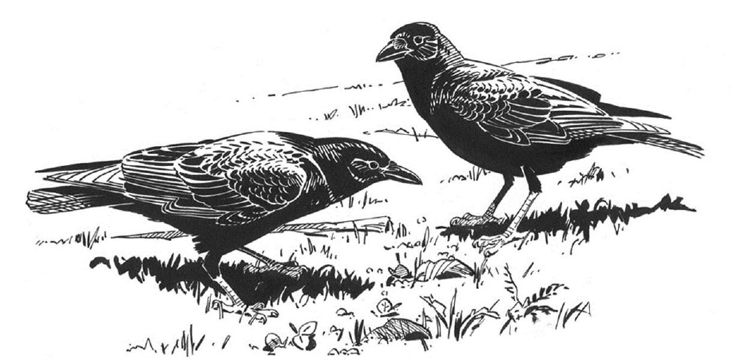 American Crows. Illustration by Barry Van Dusen.
American Crows. Illustration by Barry Van Dusen.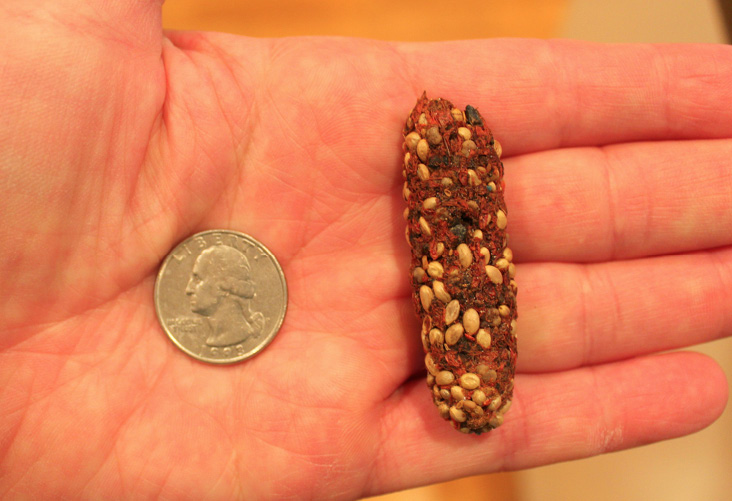 Crow pellet found at the Lawrence Winter Roost. All photographs by Craig Gibson.
Crow pellet found at the Lawrence Winter Roost. All photographs by Craig Gibson.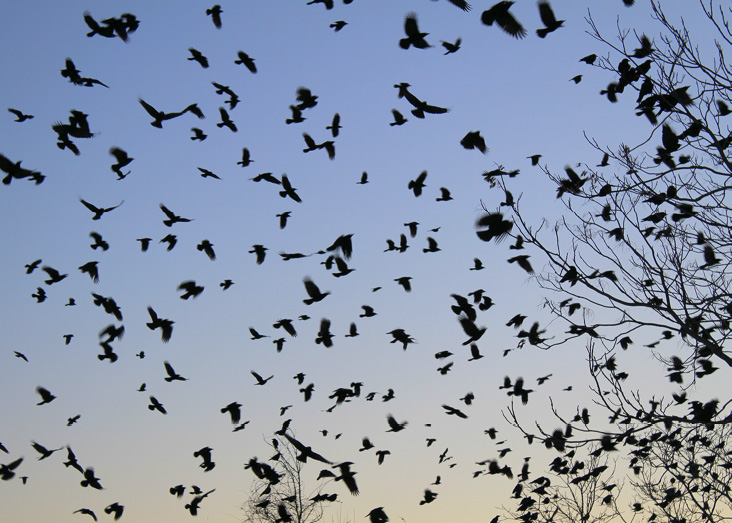 Just after sunset on December 28, 2017, hundreds, if not thousands, of crows pour into a staging area on the west side of the O’Leary Bridge Rt. 28/Broadway by the Great Stone Dam.
Just after sunset on December 28, 2017, hundreds, if not thousands, of crows pour into a staging area on the west side of the O’Leary Bridge Rt. 28/Broadway by the Great Stone Dam.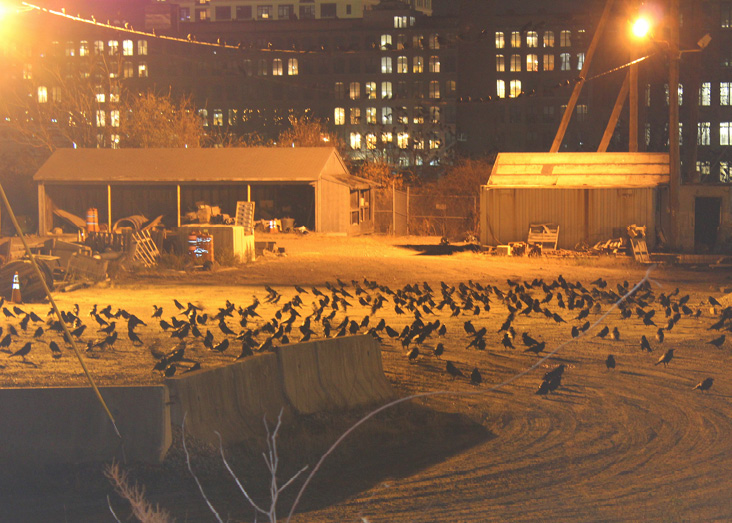 The National Grid substation on South Canal Street is one of the crows’ staging areas. Crows cover the ground, fill the trees, and perch on the utility wires.
The National Grid substation on South Canal Street is one of the crows’ staging areas. Crows cover the ground, fill the trees, and perch on the utility wires.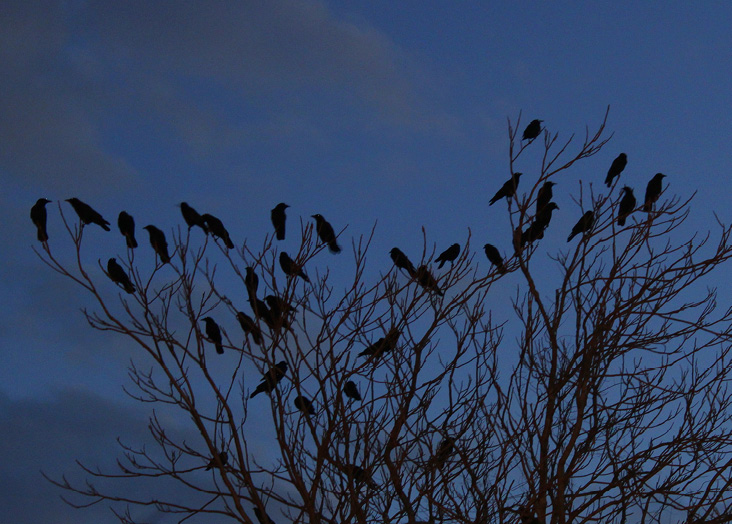 Silence falls when the crows settle into their overnight roost.
Silence falls when the crows settle into their overnight roost.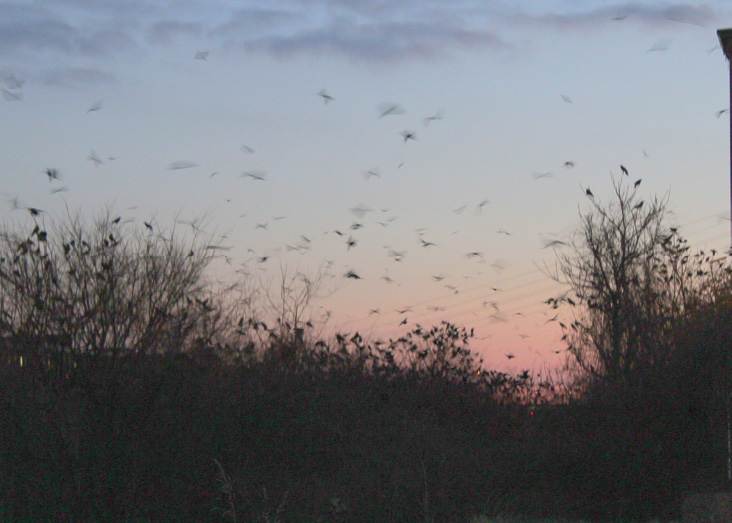 Crows leave the roost before sunrise, flying over the Merrimack River.
Crows leave the roost before sunrise, flying over the Merrimack River.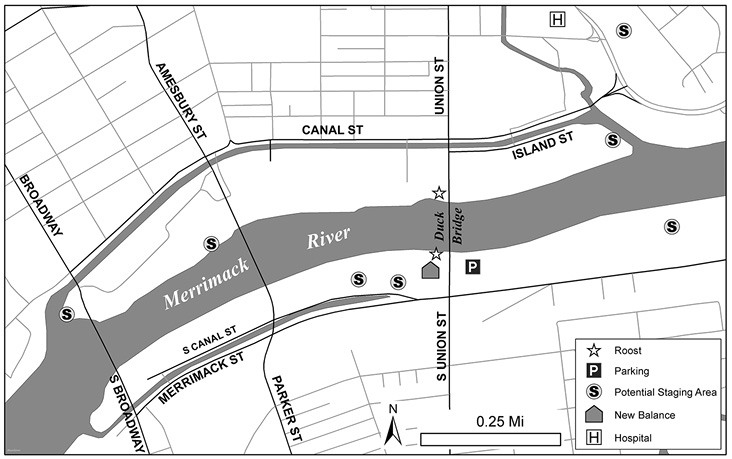 Map of Lawrence Roost and Staging Areas.
Map of Lawrence Roost and Staging Areas.